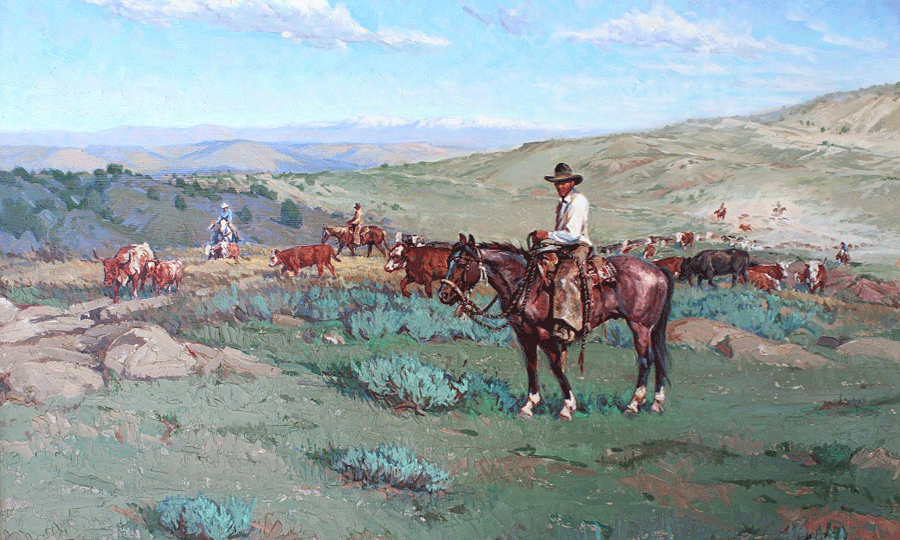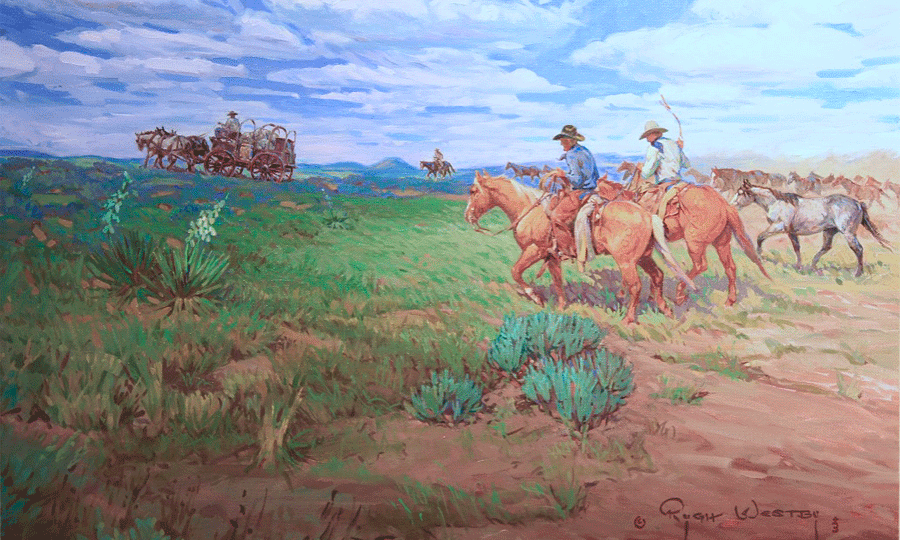Rygh Westby
Both sides of my family were pioneer homesteaders.
My Dad’s father was a Norsk immigrant who landed coincidentally in Westby, Montana. He took up a homestead on the prairies of Saskatchewan where my Dad spent the majority of his boyhood. The West was still in its’ late adolescence in northern Montana and southwestern Canada at the turn of the century. Although the Depression drove thousands off the lands of the West and into the Midwest, including my Dad and two of his three brothers, their stories of life on the open range lit a fire in me that is still as bright as it ever was.
My mother’s side of the family had been on this side of the Atlantic since before the Revolutionary War. Her grandfather came from Ohio to north central Illinois in a covered wagon when it was known as “the Prairie State”. He established a large farm that remained in production for well over 100 years.Although my Mom was raised in the country, it would be a mistake to call her a “country girl”. My Dad, having ridden to school in blizzards on a mustang pony and endured the poverty and other hardships of life in large family that moved frequently around the Northwest, had all the “romance” pretty well knocked out of him.
The Depression and then the War found him in the Chicago area which is where he met my Mom. Which is why I was not born where I should have been. The Depression did pretty much the same to my wife’s family. They had several ranches near Newcastle, Wyoming, which they lost. This forced her Dad’s father to find work in the gold mines of Colorado where he lost a leg in a mining accident (no workman’s comp back then).
When my wife and I were married in 1972 I had a camp job on the Baca Grant in southern Colorado. Her dream of marrying a cowboy (her mother’s worst nightmare) had come true. Throughout the last 47 years we have worked on ranches from Montana to Arizona and points in between. We raised our three kids where they had room to breath and love life. Keeping up a family tradition, we lost our small ranch in Wyoming (the equivalent of being blooded in battle). After that we moved back to Arizona and started a successful horse training business.
When are we going to talk about the Cowboy Art stuff? Right now. The other motivating force in my life has been the influence of men like Charlie Russell (who my great uncles in Montana knew personally), Frederic Remington, Maynard Dixon, Joe Beeler, Bill Owen, and my old compadre, Jack Swanson. Producing art is, if nothing else, a lot of hard work. For me the motivation has to be strong enough to get me off dead center. The love of horses, cattle, and the Western landscape is what makes me tick. I am fortunate to have a wife that shares this love because it’s almost like asking her to put up with a mistress sometimes.
So for us, the Cowboy West is a place where romance collides with reality, where culture clashes with commerce and common sense. After observing some of the trials and tribulations we had gone through I thought my father in law might have been disappointed in how I had done for his only daughter. But he missed his own life on the Wyoming ranch even though he had made a pretty comfortable living in Denver. But one time he told us “You know you guys have had a REAL LIFE!”That’s what I paint about; a real Cowboy life, and I’m happy to share it with anyone who wants to know.
Rygh Westby (pronounced “Rig”), has worked on cow outfits large and small throughout the west, from Montana to Arizona.
A self-taught artist, “I never took lessons, or painted with anybody, it just wasn’t possible”. Rygh painted at night while using bunkhouses or barns as his studio. While working for the historic Padlock Ranch in Montana he made his first sale of a painting through a gallery. Prior to the Rygh traded paintings to pay for doctor bills, partial payments on a saddle and the like. The sale of that small painting led to
the creation of a body of work over the next four decades. The body of work, depicting the cowboy, was created in oils, watercolors, pen and ink, and bronze.
Rygh’s work has also appeared on the cover of Western Horseman six times. For the September 1983 Western Horseman issue included the cover and a feature article by the photo journalist Kurt Markus, documenting the man and the art “A Western Artist of His Own School“. Rygh Westby also illustrated singer Ian Tyson’s book “I Never Sold My Saddle”.
On the November 2000 issue he appeared on the cover of Western Horseman as the subject of a painting by the renowned artist Jame Bama.
Most of the subject’s for Westby’s work are the men he worked with and the same is true of the horses he depicts.
My Dad’s father was a Norsk immigrant who landed coincidentally in Westby, Montana. He took up a homestead on the prairies of Saskatchewan where my Dad spent the majority of his boyhood. The West was still in its’ late adolescence in northern Montana and southwestern Canada at the turn of the century. Although the Depression drove thousands off the lands of the West and into the Midwest, including my Dad and two of his three brothers, their stories of life on the open range lit a fire in me that is still as bright as it ever was.
My mother’s side of the family had been on this side of the Atlantic since before the Revolutionary War. Her grandfather came from Ohio to north central Illinois in a covered wagon when it was known as “the Prairie State”. He established a large farm that remained in production for well over 100 years.Although my Mom was raised in the country, it would be a mistake to call her a “country girl”. My Dad, having ridden to school in blizzards on a mustang pony and endured the poverty and other hardships of life in large family that moved frequently around the Northwest, had all the “romance” pretty well knocked out of him.
The Depression and then the War found him in the Chicago area which is where he met my Mom. Which is why I was not born where I should have been. The Depression did pretty much the same to my wife’s family. They had several ranches near Newcastle, Wyoming, which they lost. This forced her Dad’s father to find work in the gold mines of Colorado where he lost a leg in a mining accident (no workman’s comp back then).
When my wife and I were married in 1972 I had a camp job on the Baca Grant in southern Colorado. Her dream of marrying a cowboy (her mother’s worst nightmare) had come true. Throughout the last 47 years we have worked on ranches from Montana to Arizona and points in between. We raised our three kids where they had room to breath and love life. Keeping up a family tradition, we lost our small ranch in Wyoming (the equivalent of being blooded in battle). After that we moved back to Arizona and started a successful horse training business.
When are we going to talk about the Cowboy Art stuff? Right now. The other motivating force in my life has been the influence of men like Charlie Russell (who my great uncles in Montana knew personally), Frederic Remington, Maynard Dixon, Joe Beeler, Bill Owen, and my old compadre, Jack Swanson. Producing art is, if nothing else, a lot of hard work. For me the motivation has to be strong enough to get me off dead center. The love of horses, cattle, and the Western landscape is what makes me tick. I am fortunate to have a wife that shares this love because it’s almost like asking her to put up with a mistress sometimes.
So for us, the Cowboy West is a place where romance collides with reality, where culture clashes with commerce and common sense. After observing some of the trials and tribulations we had gone through I thought my father in law might have been disappointed in how I had done for his only daughter. But he missed his own life on the Wyoming ranch even though he had made a pretty comfortable living in Denver. But one time he told us “You know you guys have had a REAL LIFE!”That’s what I paint about; a real Cowboy life, and I’m happy to share it with anyone who wants to know.
Rygh Westby (pronounced “Rig”), has worked on cow outfits large and small throughout the west, from Montana to Arizona.
A self-taught artist, “I never took lessons, or painted with anybody, it just wasn’t possible”. Rygh painted at night while using bunkhouses or barns as his studio. While working for the historic Padlock Ranch in Montana he made his first sale of a painting through a gallery. Prior to the Rygh traded paintings to pay for doctor bills, partial payments on a saddle and the like. The sale of that small painting led to the creation of a body of work over the next four decades. The body of work, depicting the cowboy, was created in oils, watercolors, pen and ink, and bronze.
Rygh’s work has also appeared on the cover of Western Horseman six times. For the September 1983 Western Horseman issue included the cover and a feature article by the photo journalist Kurt Markus, documenting the man and the art “A Western Artist of His Own School“. Rygh Westby also illustrated singer Ian Tyson’s book “I Never Sold My Saddle”.
On the November 2000 issue he appeared on the cover of Western Horseman as the subject of a painting by the renowned artist Jame Bama.
Most of the subject’s for Westby’s work are the men he worked with and the same is true of the horses he depicts.

LOOKING FOR A SPECIFIC PIECE?
We would be pleased to assist you in locating a western artist or Indian piece that you are particularly interested in. Contact us today to begin the search for your next piece.
CONTACT THE GALLERY










